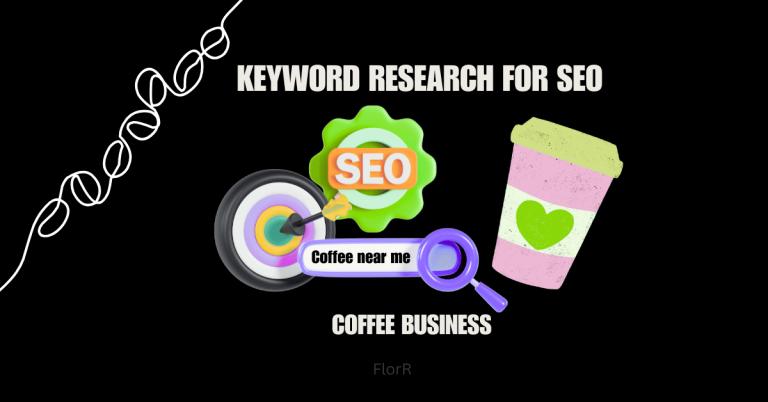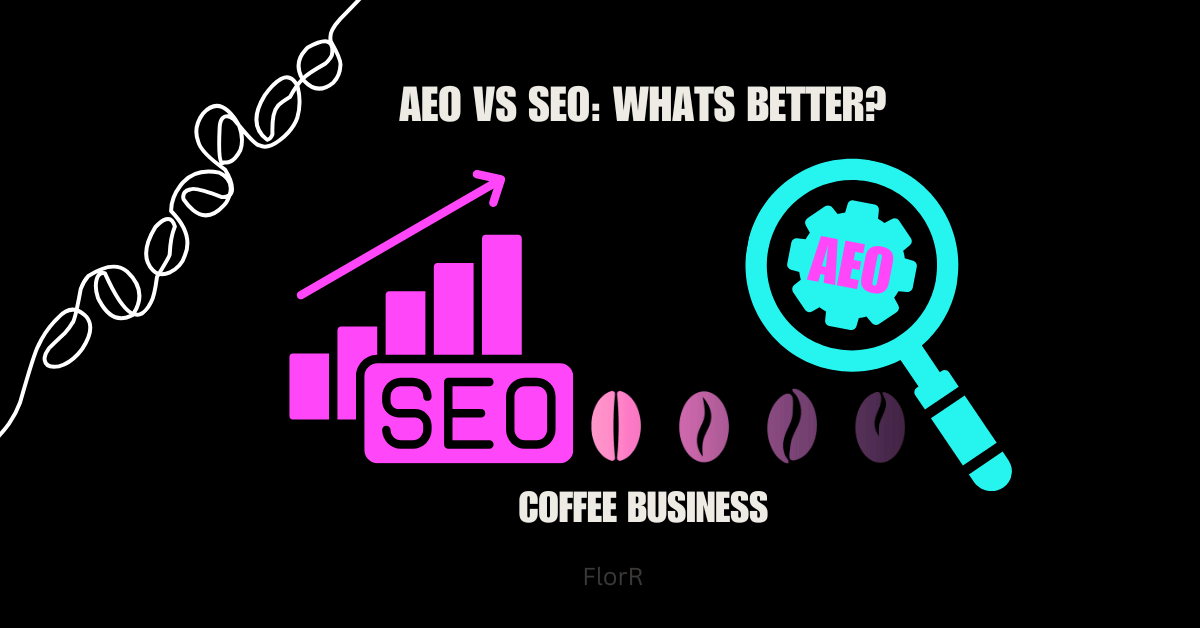
This site contains affiliate links. I may earn a commission if you purchase through these links. Thank you for being so supportive!
Wondering why your café isn’t appearing when customers ask AI assistants about local coffee? You’ve mastered SEO, but the AEO Vs SEO landscape has completely changed how customers discover cafés.
While you’re perfecting your pour-over, smart café owners are optimizing for both Google’s traditional search and AI-powered answer engines that enhance user experience through direct responses.
Here’s what successful coffee businesses understand: The AEO vs SEO debate isn’t about choosing sides; it’s about dominating both.
Traditional engine optimization and search engine tactics still matter, but AI assistants are now answering customer questions about where to find great coffee.
Would you be ready to be visible everywhere customers are searching?
Learn how to balance AEO vs SEO strategies to maximize your café’s visibility across traditional search engines and AI-powered platforms that customers increasingly use to find local businesses.
What is the Difference Between SEO Vs AEO?

SEO ensures your content ranks on Google through strategic keywords and backlinks. AEO focuses on becoming THE definitive answer to specific questions.
SEO vs AEO explained: one aims for visibility in search results, the other optimizes for being the single answer that voice assistants and AI tools serve up.
68% of all online experiences begin with search engines, but voice search is growing at 35% annually, a game-changer for café discovery.
The evolution from traditional SEO to AEO mirrors how coffee evolved from commodity to craft experience. Google dominated until 2018, when voice assistants gained traction.
Now, AI search tools have created a landscape where being the answer matters more than being on the list.
If someone asks “best coffee shops near me,” Google shows a map and list with reviews, while ChatGPT might directly recommend your shop based on specific attributes like “ethically sourced beans with great wifi.”
How Does Answer Engine Optimization Differ From SEO?
SEO ensures your content matches keywords people type, while AEO aims to address conversational questions.
You can triple discovery rates by optimizing for “where can I get a great cortado nearby?” rather than just “coffee shop Portland.”
Creating content that addresses the question behind the search with concise answers that both humans and AI can extract value from.
SEO builds authority through links and comprehensive content, while AEO focuses on structured data and direct answers.
When comparing structure requirements:
| SEO | AEO |
|---|---|
| Long-form content | Question-answer format |
| Keyword density | Conversational language |
| Link building | Featured snippet optimization |
| Meta descriptions | Schema markup |
Featured snippets appear in over 19% of search results, serving both traditional search and voice assistants equally.
Why Do Both AEO and SEO Matter for Your Café’s Digital Marketing?
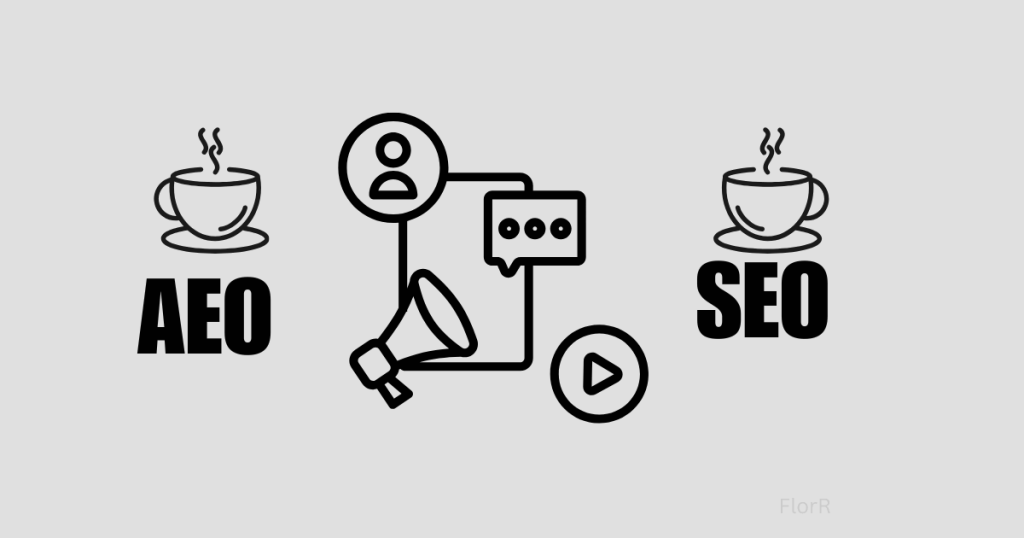
SEO and AEO form the perfect blend for complete digital visibility. SEO builds your foundation while AEO amplifies your expertise through direct answers to specific questions.
Businesses leveraging both strategies see 27% higher engagement rates, that’s the difference between surviving and thriving in today’s digital landscape.
Different customers find you through different journeys.
- Morning commuters use voice search: “Hey Google, where can I get coffee on my route?” Their query demands AEO.
- Meanwhile, tourists research “best local coffee shops with pastries” on laptops , classic SEO territory.
I recently helped a local café capture both audiences by structuring their Google Business Profile for voice search while maintaining rich website content for traditional search.
Let’s go ahead and build your strategy to leverage how AEO changes SEO strategy for maximum visibility.
What Are the Key Differences Between Traditional SEO and AEO Strategies?
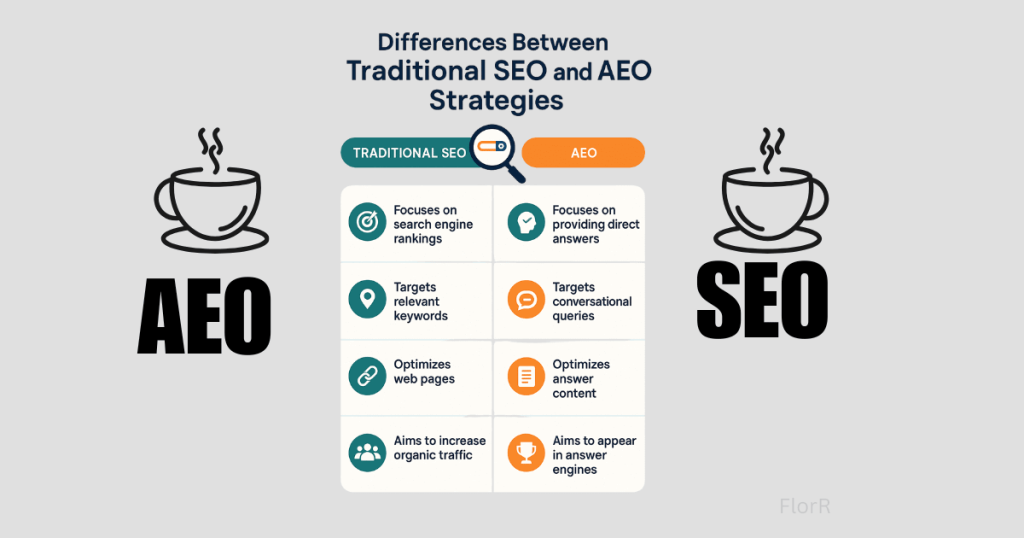
Traditional search engine optimization creates expansive content with strategic keyword placement, like your full café menu. AEO differs by focusing on direct answers to specific user queries, more like your daily specials board.
Pages using clear Q&A formats are 1.5x more likely to appear in voice search results, making this structure essential for the future of SEO with AEO rise.
Technical requirements separate these approaches fundamentally.
SEO needs basic schema markup for business info, while AEO requires extensive FAQ schema, speakable markup, and HowTo structured data.
When updating a local café site, I implemented dual-purpose content blocks, comprehensive for SEO, extractable answers for AEO impact on rankings.
How Does Keyword Research Differ for SEO and AEO?
SEO targets phrases like “best coffee shop downtown” while AEO targets “where can I get a pour-over near me?” Questions make up 8% of all search queries but 27% of voice searches, a game-changer for your keyword strategy.
For café terms, use AnswerThePublic and BuzzSumo’s Question Analyzer to find real user queries that drive AEO traffic, then blend these with traditional keyword research.
AEO focuses on natural language that mirrors conversation patterns. AI processes “got any good coffee places nearby?” differently than typed queries.
Optimize for these voice search queries:
- “coffee shop with wifi open now,”
- “who makes the best cold brew in [location],”
- “Where can I work with a laptop and coffee?”
You can attract new customers from the surprising voice query “where can parents with strollers get good coffee?”
How Do User Experience Requirements Compare Between SEO and AEO?
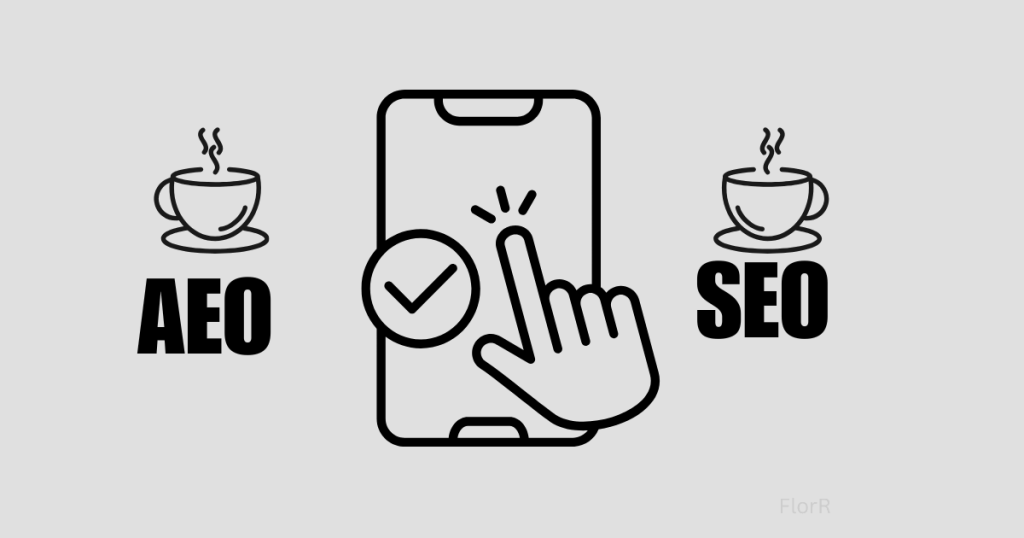
Both optimization and search engine optimization demand lightning-fast loading, your café site needs that 3-second benchmark. 53% of mobile visits bounce if pages load slower than 3 seconds, killing your SEO and eliminating AEO chances completely.
The perfect blend balances speed with answers that satisfy both platforms. Use mobile-first design with prominent answer blocks.
SEO content organizes café information hierarchically with descriptive headings, while AEO requires conversational chunks with direct answers.
When I revamped a local café menu page, we transformed “Our Specialty Drinks” into scannable Q&A pairs: “What specialty drinks do you offer?” followed by concise answers, driving 32% more search traffic across both channels.
How Can Cafés Optimize for Answer Engines Like ChatGPT and Perplexity?
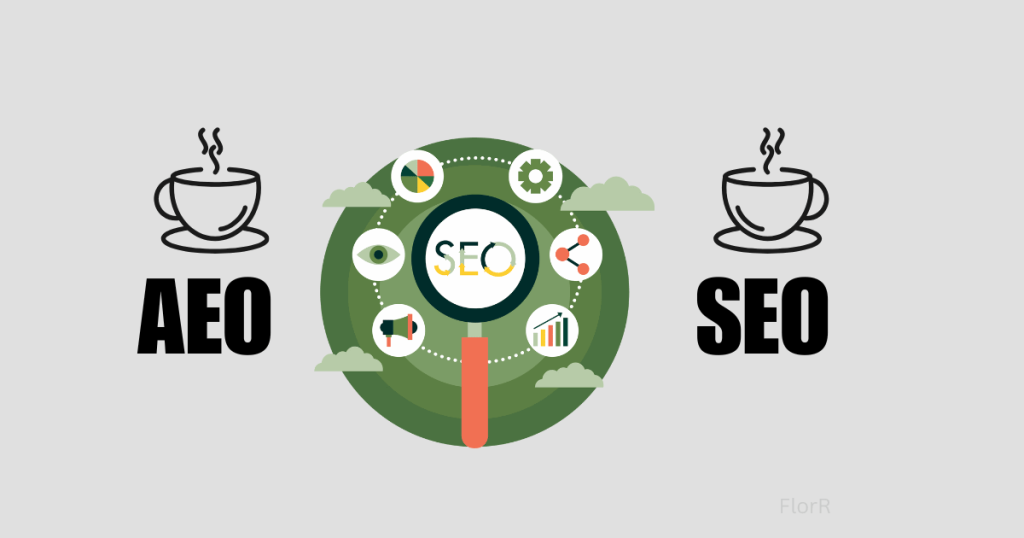
Creating content for AEO vs SEO requires restructuring how you present information.
Use direct question-answer pairs instead of flowing paragraphs. Content structured as direct answers is 30% more likely to be featured in AI responses, while search engines like Google still value comprehensive coverage.
The perfect blend includes FAQ sections that answer engines love to extract from.
Schema markup tells AI exactly what your café offers. Implement LocalBusiness, Menu, and FAQ schema without coding using Schema App or Yoast SEO.
After implementing HowTo schema for a local café brewing guides, their visibility jumped 40% across both traditional search and answer engines, proving things SEO cannot accomplish alone.
What Type of Content Should Cafés Create to Optimize for AEO?
Focus on answering essential questions: “What are your hours?” “Do you have WiFi?” “What non-dairy options do you offer?” Creating content that focuses on delivering direct answers to these questions builds trust and authority with both users and AI engines.
Pages directly answering “What,” “How,” and “Why” questions receive 25% more engagement than traditional content formats.
Write conversationally, as if answering a real customer. Instead of “Our espresso features notes of chocolate and cherry,” try “What does our espresso taste like? You’ll enjoy rich chocolate notes with hints of cherry.”
A local café saw 38% more voice discoveries after we rewrote their menu descriptions using natural language patterns that match how people actually speak about coffee.
How Can You Measure AEO Success Compared to Traditional SEO?
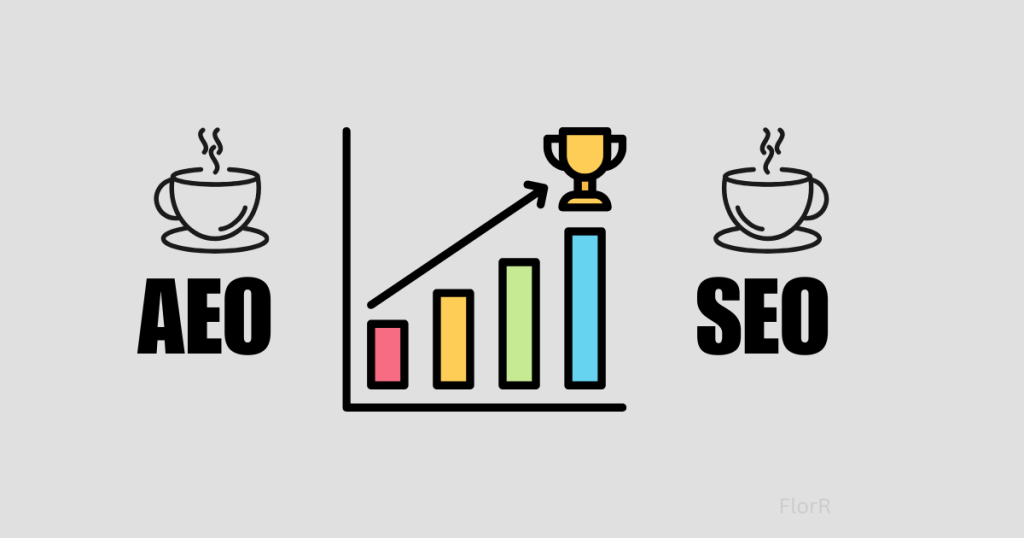
While traditional SEO metrics like rankings matter, AEO requires tracking featured snippets and answer box appearances. Use SEMrush‘s Position Zero tracker or AnswerThePublic insights to measure answer visibility.
Featured snippet visibility increases click-through rates by 8.6%, directly impacting your bottom line.
Like SEO, AEO builds trust and authority over time.
SEO shows results in 3-6 months, but AEO can deliver faster wins within 4-8 weeks with proper implementation. Café industry benchmarks suggest a 15% increase in discovery-based traffic is achievable in the first quarter.
After implementing dual strategies for a local cafe, their discovery traffic increased 26% and direct lookups rose 19% within just two months.
How Does GEO (Generative Engine Optimization) Relate to SEO and AEO?
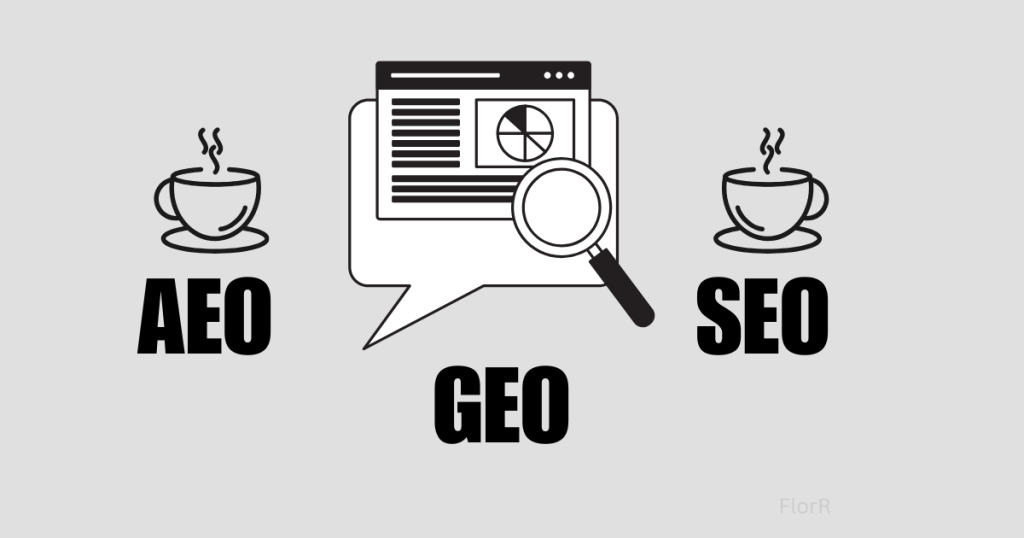
While SEO drives organic traffic through rankings and AEO provides direct and precise answers to specific questions, GEO focuses on optimizing content for AI-generated summaries.
Think of it as preparing your café information to be curated, not just discovered or quoted. AI-generated search results are growing by 70% year over year, making this strategy increasingly important.
For resource allocation, start with strong SEO fundamentals, add AEO elements second, then implement GEO. Small cafés should focus on optimizing their Google Business Profile first, then create FAQ content for AEO before exploring GEO.
My framework guides clients through SEO implementation in month one, AEO in month two, with GEO additions only after establishing baseline visibility.
What Are the Technical Requirements for GEO vs SEO and AEO?
GEO demands storytelling structures while answer engine optimization and search require direct and concise answers. For GEO, create content that connects data points into cohesive narratives about your café’s unique offerings.
Use tools like Frase.io or MarketMuse to identify topic clusters that generative AI combines well.
Content optimized for generative AI receives 22% more engagement on social platforms, particularly when sharing café innovations.
Create multipurpose content blocks:
- Keyword-optimized headlines (SEO)
- Direct Q&A pairs (AEO)
- Contextual stories (GEO).
My café clients use my “Triple-Threat Template”, one content calendar that generates all three formats simultaneously, saving 7+ hours weekly while covering all bases.
How Will AI Impact Local SEO for Cafés?
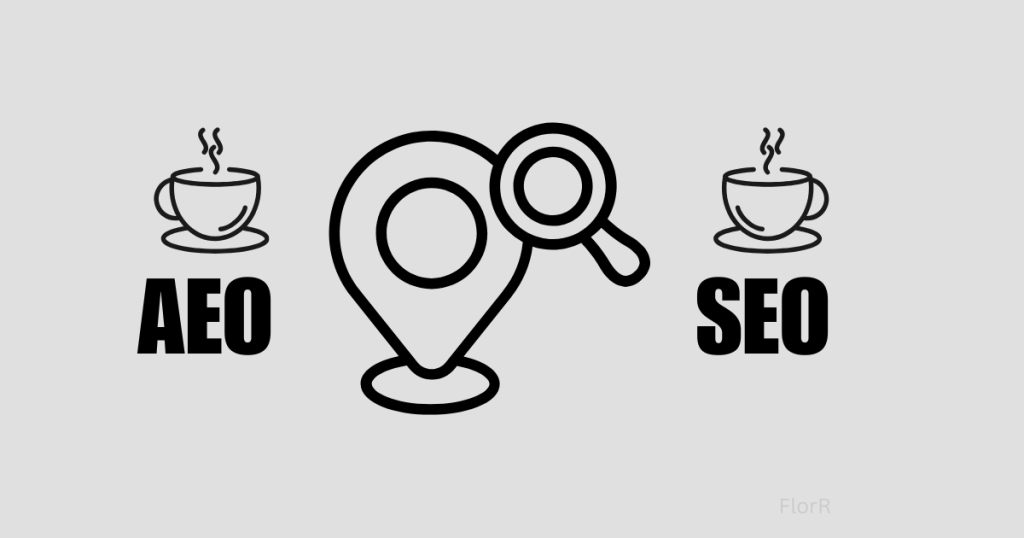
The difference between optimizing for Google vs optimizing for answers shows dramatically in local searches.
While 46% of all Google searches have local intent, answer engines change how these “near me” queries get fulfilled, prioritizing direct and precise answers over proximity alone.
Local intent now considers ambiance, menu specialties, and customer experience.
Prepare by ensuring complete schema markup with Local Business, Opening Hours, and Menu elements. Beyond consistent NAP (Name, Address, Phone), add answers to common customer questions directly in your Google Business Profile.
A local café saw 54% more first-time visitors after we optimized their profile with detailed response sections addressing the top questions potential customers asked about their pour-over options and workspace availability.
Which Strategy Should Your Café Prioritize: SEO or AEO?
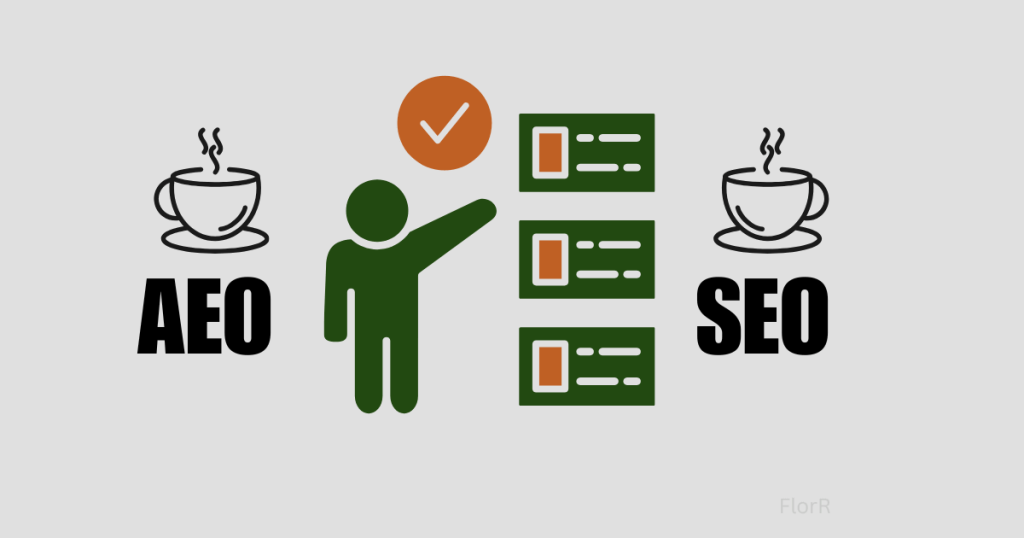
The future of SEO with AEO rise demands strategic planning rather than choosing one over the other. Assess your goals: Need immediate foot traffic? Balance equally.
Building long-term authority? Start with 70% SEO, 30% AEO.
Answer three questions:
- Who’s your core customer?
- How do they discover cafés?
- What’s your technical comfort level?
For established cafés in tourist areas, I recommend stronger SEO focus initially, while neighborhood spots serving tech-savvy commuters benefit from earlier AEO adoption.
Implement a 3-month rollout: Month 1 for core SEO, Month 2 adding AEO elements, Month 3 integrating both. Expect 4-6 month ROI timeline, with businesses balancing both seeing 32% higher conversion rates than those using single-strategy approaches.
When Should You Focus on Traditional SEO Strategies?
SEO remains essential for driving discovery when your target customers use traditional search methods. Tourist-focused cafés benefit most from strong SEO since visitors research destinations through conventional searches before arriving.
When a New café opened near the entrance to the historic lighthouse park, they prioritized local SEO over AEO, resulting in a 47% increase in tourist visits
Your SEO foundation must include:
- Optimized Google Business Profile,
- Locally-relevant keywords,
- Mobile-friendly design,
- Location-based content,
- Quality backlinks from local sites.
Websites on page 1 of Google capture 92% of traffic, making traditional SEO still crucial despite rising AEO importance.
When Will AEO Give Your Café a Competitive Edge?
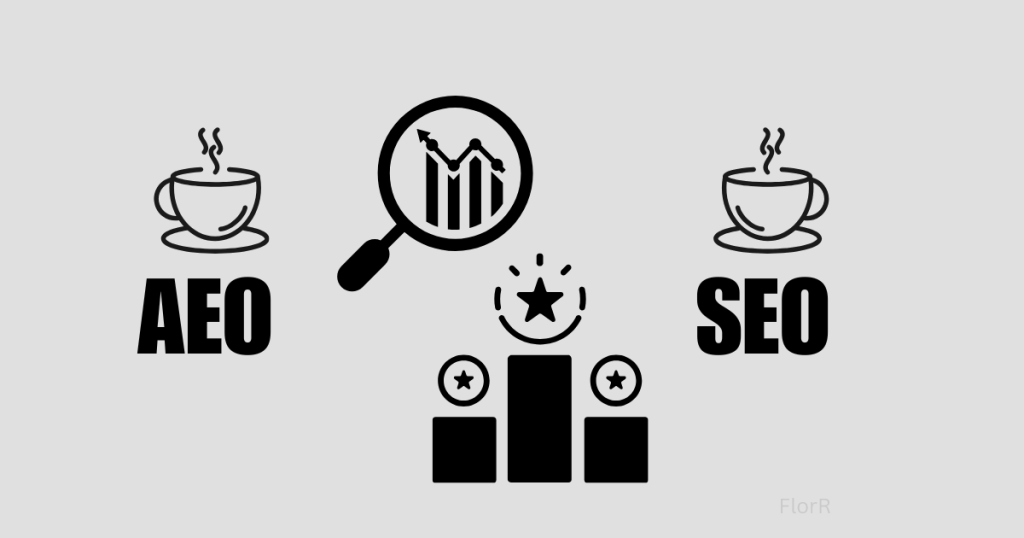
AEO represents your best investment when targeting tech-forward demographics who rely on voice assistants and AI tools.
Commuter-focused cafés gain immediate advantages from AEO since 62% of consumers have used voice search while driving, asking about “coffee shops open now” or “drive-through coffee near me.”
Natural language processing excels at matching conversational user inquiries with cafés that provide direct answers.
Five immediate AEO implementations:
- Add FAQ schema,
- Create “How” and “What” content blocks,
- Implement speakable markup,
- Location-specific answers,
- Optimize for “near me” queries.
SimpleSite and Schema App make this accessible without coding knowledge.
A local café generated 28 new weekly customers just 17 days after implementing AEO for drive-time commuters asking about breakfast options.
How Can Cafés Build a Strategy That Leverages Both SEO and AEO?

Creating content for AEO vs SEO isn’t an either/or decision, the perfect blend incorporates both. Structure each content piece with SEO-optimized headlines and comprehensive information, while embedding direct answers to user queries within the same page.
Integrated approaches increase organic traffic by 38% on average, significantly outperforming single-strategy efforts.
Streamline implementation with tools like Frase.io for identifying questions and ContentCal for planning dual-purpose content.
My “Triple Impact Content System” helps café owners create one piece of content weekly that serves traditional search, voice search, and social media simultaneously.
Record a video answering common questions, then repurpose as blog post (SEO) and FAQ page (AEO).
What Are Common Questions About Implementing SEO and AEO Together?
“Is AEO better than SEO?” Neither is inherently better, they serve different discovery paths. Understanding the key differences helps you implement both strategically without conflict.
“Will AEO content hurt my SEO?” No, when done correctly, AEO content enhances SEO by improving engagement metrics.
73% of businesses struggle to balance multiple digital marketing strategies, particularly smaller cafés with limited resources.
The biggest implementation challenge is conflicting content structures.
Solution: Create modular content with SEO-optimized introductions and AEO-friendly Q&A sections.
A local café increased visibility by 44% after reorganizing their content to include both comprehensive topic coverage (SEO) and direct answer blocks (AEO) rather than creating separate pages for each.
How Can Your Café Stay Ahead of the Curve in Digital Marketing?

In the world of digital marketing, multi-modal search is next; combining text, voice, and image recognition.
Search engine results pages are evolving toward knowledge panels over traditional link lists. AI-driven search is projected to make up 30% of all searches by next year, with AEO ensures visibility in these results.
Watch developments in visual search and social commerce integration.
Before adopting new tactics, ask:
- Does this align with how my customers actually discover cafés?
- Does it integrate with existing strategies?
- Can we implement it with current resources?
When helping a local café future-proof their strategy, we created a quarterly digital audit system to evaluate emerging trends against their specific customer demographics rather than chasing every new platform, resulting in 26% higher ROI on marketing spend.
Key Takeaway
- SEO vs AEO explained: SEO ranks your café on search engine algorithms; AEO makes you the answer to specific questions.
- The difference between AEO and SEO isn’t which is better, but how they complement each other for maximum visibility.
- User intent varies: traditional searchers browse options while voice searchers want direct answers.
- The perfect strategy integrates both search engine optimization and answer engine optimization with consistent social media marketing.
- Tomorrow’s café success depends on adapting to both, not choosing between them.
Final Thoughts
SEO builds your foundation in search results while AEO caters to voice-activated discovery – complementary strategies rather than competing approaches.
Traditional search engine optimization drives broad visibility, while answer engine optimization captures intent-specific customers asking precise questions.
The perfect blend for most cafés is a strategy that prioritizes SEO for foundation and AEO for competitive edge. Your digital presence needs both to thrive in today’s complex search ecosystem.
Time to refill your digital strategy with these AEO techniques while maintaining your SEO strength. Start with your FAQ page today, then gradually optimize your entire site for both discovery paths.
FAQs
What is AEO (Answer Engine Optimization)?
AEO optimizes content for AI tools like ChatGPT to provide direct answers. For cafés, it means structuring your “What coffee do you serve?” as clear Q&A.
Is SEO still important for café websites?
Yes, including technical SEO remains crucial. The future of SEO with AEO rise requires both – SEO for discovery, AEO for direct answers to customer questions.
How do I optimize my café website for voice search?
Use conversational language and understand user intent better. Answer questions like “Where’s good coffee near me?” directly on your homepage with clear responses.
What’s the difference between GEO and AEO?
Answer engine optimization vs search engine optimization: AEO provides direct answers within the answer engines, while GEO optimizes for AI-generated content summaries.
How can I measure if my AEO strategy is working?
Track featured snippets, voice search rankings, and direct answer appearances. AEO also emphasizes engagement metrics from question-based content performance.


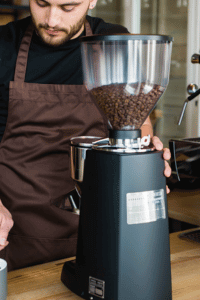
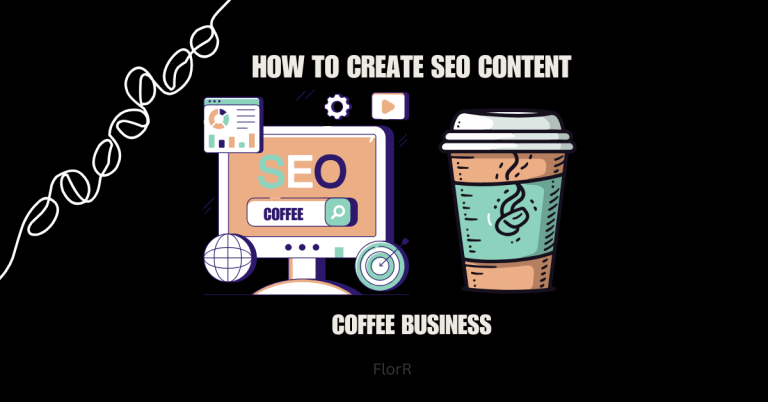

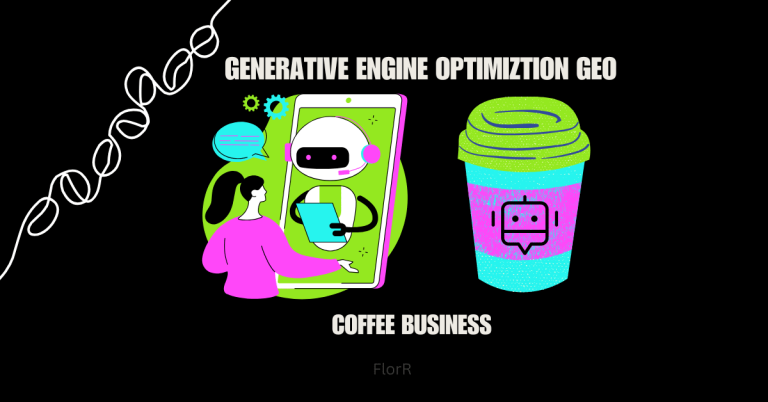
![How to Start a Blog for Coffee Shop Success [2025 guide] 7 How to Start a Blog for Coffee Shop](https://byflorr.com/wp-content/uploads/2025/03/How-to-Start-a-Blog-for-Coffee-Shop-1-768x402.png)
